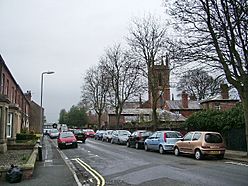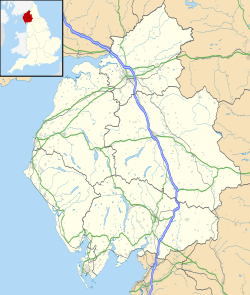Petriana facts for kids
Quick facts for kids Uxelodunum |
|
|---|---|

Church Street, Stanwix. The fort was in the area around St Michael's church
|
|
| Alternative name(s) | Petriana |
| Known also as | Stanwix Fort |
| Location | |
| Coordinates | 54°54′18″N 2°56′31″W / 54.905°N 2.942°W |
| County | Cumbria |
| Country | England |
| Reference | |
| UK-OSNG reference | NY396571 |
Uxelodunum was a large Roman fort. It was also known as Petriana and is now called Stanwix Fort. This fort was the biggest one along Hadrian's Wall. Today, it is hidden beneath the area of Stanwix, which is a part of Carlisle, Cumbria, England.
Contents
What's in a Name?
The Roman fort had a few different names. In an old Roman document called the Notitia Dignitatum, it was called Petrianis. But on another old map, the Ravenna Cosmography, it was named Uxellodamo.
Other Roman objects like the Rudge Cup, the Amiens Skillet, and the Staffordshire Moorlands Pan all call it VXELODVNVM. The name Petrianis likely came from the Roman army unit that was stationed there. Uxelodunum is thought to be a Latin version of a Celtic word. It probably means High Fort.
It seems that Petriana might have been a mistake by someone writing down the name. They might have confused the fort's real name with the name of the soldiers who lived there. So, the fort's true name was probably Uxelodunum.
About the Fort
Uxelodunum was located about 40 miles west of the fort of Castlesteads and about five and a half miles east of Burgh by Sands. It was built on a natural high area above the River Eden.
The fort was very large, measuring about 580 feet from north to south and 700 feet from east to west. This covered an area of about 9.32 acres, which was much bigger than other forts on Hadrian's Wall. The wall itself ran along the north side of the fort. It seems the fort was built to protect the crossing point over the River Eden and to watch over an important route to and from Scotland.
Today, the fort is completely covered by buildings in the modern area of Stanwix in Carlisle.
Who Lived at the Fort?
Because of its huge size, experts believe that Uxelodunum was home to a large cavalry regiment. This was a unit of 1,000 horse soldiers. This unit was almost certainly the Ala Petriana. This was a very respected auxiliary regiment, which means they were not regular Roman legions but allied troops. Their soldiers had even been made Roman citizens because they showed great bravery in battle. It looks like the fort was eventually named after this important group of soldiers, replacing its older name of Uxelodunum.
Digging Up the Past: Discoveries at Uxelodunum
Archaeologists have done many digs at the site of Uxelodunum.
- In 1932–1934, they found the ditch for the fort's south wall. They also found parts of Hadrian's Wall, which made up the north side of the fort. Buildings that looked like barracks for soldiers were also found inside the fort's boundaries.
- In 1939, a large granary (a building for storing grain) was discovered when a local schoolyard was being expanded.
- In 1940, the fort's southwest corner tower was found, along with parts of the south and east walls.
- In 1934, various objects were found in the river nearby. These items, like brooches and parts of cavalry uniforms, seemed to have been washed down from the fort.
- The Vallum, a large ditch and earthwork that ran south of Hadrian's Wall, has been traced close to the fort's southeast corner.
A really exciting discovery happened in 2017. Archaeologists found the fort's bath-house near the river, under the grounds of the Carlisle Cricket Club. The remains were very well-preserved. They included a hypocaust, which was an ancient Roman heating system that used hot air under the floors.
They also found an inscription dedicated to Julia Domna. She was the mother of the Emperor Caracalla and the wife of Emperor Septimius Severus. Julia Domna was in Britain with her husband from 208 AD until he died in 211 AD in York. This discovery makes us wonder: did Julia Domna and her husband actually visit Petriana?


